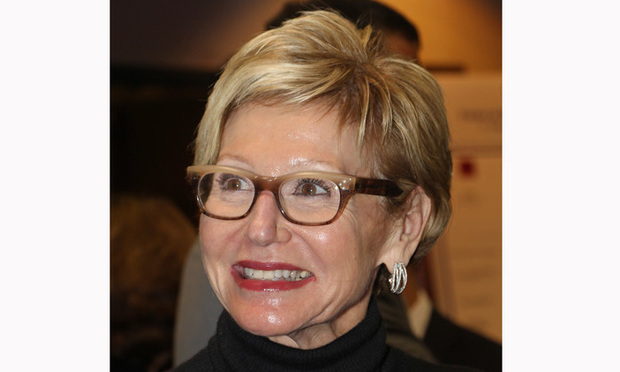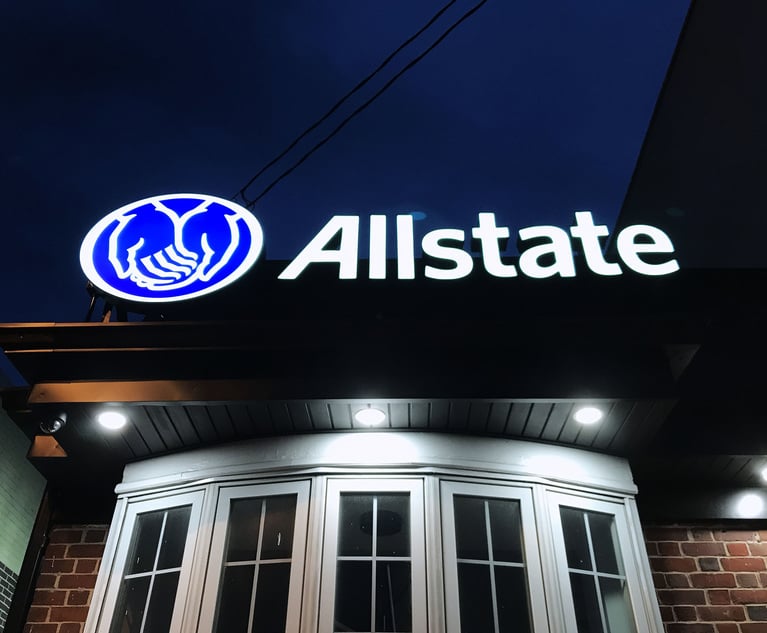Pollution Exclusion Bars Insurance Coverage for Oil-Based Paint Fumes
U.S. District Judge Ursula Ungaro dismissed a case against an insurance company facing a bodily injury claim from paint fumes in an office building.
March 07, 2019 at 03:33 PM
3 minute read
 U.S. District Judge Ursula Ungaro. Photo: J. Albert Diaz
U.S. District Judge Ursula Ungaro. Photo: J. Albert Diaz
A federal district court in Miami ruled an insurance policy's pollution exclusion precluded coverage of a lawsuit against the owner and manager of an office building by a plaintiff claiming she suffered bodily injury after inhaling fumes from oil-based paint used to paint a floor of the building.
The Case
In August 2018, Sadie Williams-Panton filed a personal injury lawsuit in a Florida court against Sunnyvale Corp. N.V., and Mink & Mink Inc. Williams-Panton alleged that on or about January 14, 2017, Mink, the property manager of an office building in Fort Lauderdale owned by Sunnyvale, hired a painter to the building's sixth floor. Williams-Panton asserted that from Jan. 14-16, 2017, the painter painted the sixth floor of the building with an oil-based paint without providing any kind of ventilation.
According to Williams-Panton, on Jan. 17, 2017, she reported to work on the sixth floor of the building when she immediately became overwhelmed with fumes from the oil-based paint, which allegedly caused her to become ill and suffer personal injury as the oil-based paint continued to recirculate through the building's air conditioning unit.
Williams-Panton alleged that the “inhaling” of the “toxic fumes” from the oil-based paint resulted in her sustaining injuries.
AIX Specialty Insurance Co .filed a complaint in the U.S. District Court for the Southern District of Florida, seeking a declaration that it had no duty to defend or indemnify Sunnyvale or Mink under the insurance policy it had issued to them. AIX argued that pursuant to the pollution exclusion in its policy, Williams-Panton's claim for personal injury arising out of the oil-based paint fumes was not covered by its policy.
AIX moved for summary judgment.
The District Court's Decision
U.S. District Judge Ursula Ungaro, applying Florida law, granted the motion.
In its decision, the judge explained the pollution exclusion in the AIX policy excluded coverage for “body injury” resulting from “pollutants,” defined as “any … gaseous … irritant or contaminant, including smoke [and] vapor.”
The district court added that the AIX policy defined “bodily injury” as “bodily injury, sickness or disease sustained by a person, including death resulting from any of these at any time.”
Then, the district court pointed out Williams-Panton alleged “the paint fumes from the oil-based paint continued to recirculate through the b]uilding's air condition unit causing [her] to become ill and suffer personal injury” and that she inhaled “the toxic fumes from the oil-based paint and therefore sustained injury.”
The district court agreed with AIX that Williams-Panton alleged that she suffered bodily injury arising from oil-based paint vapors and irritants, making her claim “clearly subject” to the pollution exclusion.
The case is Aix Specialty Insurance. v. Williams-Panton, No.: 0:18-cv-62553-UU (S.D. Fla. March 4, 2019).
This content has been archived. It is available through our partners, LexisNexis® and Bloomberg Law.
To view this content, please continue to their sites.
Not a Lexis Subscriber?
Subscribe Now
Not a Bloomberg Law Subscriber?
Subscribe Now
NOT FOR REPRINT
© 2025 ALM Global, LLC, All Rights Reserved. Request academic re-use from www.copyright.com. All other uses, submit a request to [email protected]. For more information visit Asset & Logo Licensing.
You Might Like
View All

Plaintiffs Attorneys Awarded $113K on $1 Judgment in Noise Ordinance Dispute
4 minute read
US Judge Cannon Blocks DOJ From Releasing Final Report in Trump Documents Probe
3 minute read
Trending Stories
- 1Georgia Hacker Pleads Guilty in SEC X Account Scam That Moved Markets
- 2Trump's Pick for SEC Chair Likely to Stymie Shareholder Proposals from ESG Advocates
- 3Adobe’s Chief Cyber Legal & Privacy Officer Talks Managing Gen AI Risks, Cyber Training
- 4The M&A Partners Who Drove the Most Business as Deal Leads Last Year
- 5Recent Ford Bronco Battery Recall Draws Pa. Class Action
Who Got The Work
J. Brugh Lower of Gibbons has entered an appearance for industrial equipment supplier Devco Corporation in a pending trademark infringement lawsuit. The suit, accusing the defendant of selling knock-off Graco products, was filed Dec. 18 in New Jersey District Court by Rivkin Radler on behalf of Graco Inc. and Graco Minnesota. The case, assigned to U.S. District Judge Zahid N. Quraishi, is 3:24-cv-11294, Graco Inc. et al v. Devco Corporation.
Who Got The Work
Rebecca Maller-Stein and Kent A. Yalowitz of Arnold & Porter Kaye Scholer have entered their appearances for Hanaco Venture Capital and its executives, Lior Prosor and David Frankel, in a pending securities lawsuit. The action, filed on Dec. 24 in New York Southern District Court by Zell, Aron & Co. on behalf of Goldeneye Advisors, accuses the defendants of negligently and fraudulently managing the plaintiff's $1 million investment. The case, assigned to U.S. District Judge Vernon S. Broderick, is 1:24-cv-09918, Goldeneye Advisors, LLC v. Hanaco Venture Capital, Ltd. et al.
Who Got The Work
Attorneys from A&O Shearman has stepped in as defense counsel for Toronto-Dominion Bank and other defendants in a pending securities class action. The suit, filed Dec. 11 in New York Southern District Court by Bleichmar Fonti & Auld, accuses the defendants of concealing the bank's 'pervasive' deficiencies in regards to its compliance with the Bank Secrecy Act and the quality of its anti-money laundering controls. The case, assigned to U.S. District Judge Arun Subramanian, is 1:24-cv-09445, Gonzalez v. The Toronto-Dominion Bank et al.
Who Got The Work
Crown Castle International, a Pennsylvania company providing shared communications infrastructure, has turned to Luke D. Wolf of Gordon Rees Scully Mansukhani to fend off a pending breach-of-contract lawsuit. The court action, filed Nov. 25 in Michigan Eastern District Court by Hooper Hathaway PC on behalf of The Town Residences LLC, accuses Crown Castle of failing to transfer approximately $30,000 in utility payments from T-Mobile in breach of a roof-top lease and assignment agreement. The case, assigned to U.S. District Judge Susan K. Declercq, is 2:24-cv-13131, The Town Residences LLC v. T-Mobile US, Inc. et al.
Who Got The Work
Wilfred P. Coronato and Daniel M. Schwartz of McCarter & English have stepped in as defense counsel to Electrolux Home Products Inc. in a pending product liability lawsuit. The court action, filed Nov. 26 in New York Eastern District Court by Poulos Lopiccolo PC and Nagel Rice LLP on behalf of David Stern, alleges that the defendant's refrigerators’ drawers and shelving repeatedly break and fall apart within months after purchase. The case, assigned to U.S. District Judge Joan M. Azrack, is 2:24-cv-08204, Stern v. Electrolux Home Products, Inc.
Featured Firms
Law Offices of Gary Martin Hays & Associates, P.C.
(470) 294-1674
Law Offices of Mark E. Salomone
(857) 444-6468
Smith & Hassler
(713) 739-1250






